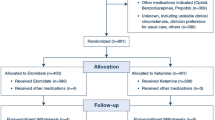Abstract
This practical guide has been developed to ensure safe and effective sedation performed in adult patients outside of the operating room, for instance in intensive care units and dental treatment rooms and in the field of palliative care. Sedation levels are classified based on level of consciousness, airway reflex, spontaneous ventilation, and cardiovascular function. Deep sedation induces loss of consciousness and protective reflexes, and can cause respiratory depression and pulmonary aspiration. Invasive medical procedures necessitating deep sedation include cardiac ablation, endoscopic submucosal dissection, and internal radiation therapy. Appropriate analgesia is necessary for procedures that require deep sedation. The sedationist should evaluate the risks of the planned procedure, explain the sedation process to the patient, and obtain the patient’s informed consent. Major parameters to be evaluated preoperatively are the patient’s airway and general condition. Equipment, instruments, and drugs necessary for emergency situations should be defined and routinely maintained. To prevent aspiration, patients scheduled for moderate or deep sedation should fast preoperatively. In both inpatients and outpatients, biological monitoring should be continued until the discharge criteria are met. Anesthesiologists should be involved in management systems that ensure safe and effective sedation even if they do not personally perform all sedation procedures.

Similar content being viewed by others
Data Availability
Data sharing is not applicable to this article as no datasets were generated or analyzed during the current study.
References
Barr J, Fraser GL, Puntillo K, Ely EW, Gélinas C, Dasta JF, Davidson JE, Devlin JW, Kress JP, Joffe AM, Coursin DB, Her DL, Tung A, Robinson BRH, Fontaine DK, Ramsay MA, Riker RR, Sessler CN, Pun B, Skrobik Y, Jaeschke R. American college of critical care medicine. Clinical practice guidelines for the management of pain, agitation, and delirium in adult patients in the intensive care unit. Crit Care Med. 2013;41:263–306.
Yuksel O, Parlak E, Köklü S, Ertugul I, Tunç B, Sahin B. Conscious sedation during endoscopic retrograde cholangiopancreatography: midazolam or midazolam plus meperidine? Eur J Gastroenterol Hepatol. 2007;19:1002–6.
Yaster M, Cote CJ, Krane EJ, Kaplan RF, Lappe DG. Sedation documentation and record keeping. In: Pediatrics Pain Management and Sedation Handbook. Maryland Heights: Mosby; 1997. p. 321–9.
Selbst SM. Medicolegal risks and outcomes of sedation. In: Mason KP, editor. Pediatric sedation outside of the operating room. A multispecialty international collaboration. New York: Springer; 2011. p. 419–20.
Tith S, Lalwani K, Fu R. Complication of three deep sedation methods for magnetic resonance imaging. J Anaesthesiol Clin Pharmacol. 2012;28:178–84.
Section on Pediatric Pulmonology, Subcommittee on Obstructive Sleep Apnea Syndrome. American Academy of Pediatrics. Clinical practice guideline: diagnosis and management of childhood obstructive sleep apnea syndrome. Pediatrics. 2002;109:704–12.
Schechter MS. Technical report: diagnosis and management of childhood obstructive sleep apnea syndrome. Pediatrics. 2002;109: e69.
Coté C, Zaslavsky A, Downes JJ, Kurth CD, Welborn LG, Warner LO, Malviya SV. Postoperative apnea in former preterm infants after inguinal herniorrhaphy. Anesthesiology. 1995;82:809–22.
Litman RS, Kottra JA, Berkowitz RJ, Ward DS. Upper airway obstruction during midazolam/nitrous oxide sedation in children with enlarged tonsils. Pediatr Dent. 1998;20:318–20.
Fishbaugh DF, Wilson S, Preisch JW, Weaver JM. Relationship of tonsil size on an airway blockage maneuver in children during sedation. Pediatr Dent. 1997;19:277–81.
Mallampati SR, Gatt SP, Gugino LD, Desai SP, Waraksa B, Freiberger D, Liu PL. A clinical sign to predict difficult tracheal intubation: a prospective study. Can Anaesth Soc J. 1985;32:429–34.
Gl S, Young JR. Difficult tracheal intubation: a retrospective study. Anaesthesia. 1987;42:487–90.
American Academy of Pediatrics, American Academy of Pediatric Dentistry, Coté CJ, Wilson S, Work Group on Sedation. Guidelines for monitoring and management of pediatric patients during and after sedation for diagnostic and therapeutic procedures: An update. Pediatrics. 2006;118:2587–602.
American Society of Anesthesiologists Task Force on Sedation and Analgesia by Non-Anesthesiologists. Practice Guidelines for Sedation and Analgesia by Non- Anesthesiologists. Anesthesiology. 2002;96:1004–17.
National Clinical Guideline Centre (UK). Sedation in children and young people: sedation for diagnostic and therapeutic procedures in children and young people. In: NICE clinical guidelines, vol. 112. London, UK: Royal College of Physicians; 2010.
2010. Available at: https://www.nice.org.uk/guidance/cg112/evidence/full-guideline-136287325. Accessed on 01 Oct 2022.
Brady M, Kinn S, Ness V, O’Rourke K, Randhawa N, Stuart P. Preoperative fasting for preventing perioperative complications in children. Cochrane Database Syst Rev. 2009;7:CD005285.
Lightdale JR, Goldmann DA, Feldman HA, Newburg AR, DiNardo JA, Fox VL. Microstream capnography improves patient monitoring during moderate sedation: a randomized, controlled trial. Pediatrics. 2006;117:e1170–8. https://doi.org/10.1542/peds.2005-1709.
WHO Guidelines for Safe Surgery. World Health Organization. 2009. Available at: https://www.who.int/patientsafety/safesurgery/tools_resources/9789241598552/en/. Accessed on 01 Oct 2022.
Aldrete JA. The post-anesthesia recovery score revisited. J Clin Anesth. 1995;7:89–91.
Practice guidelines for moderate procedural sedation and analgesia. A report by the American Society of anesthesiologists task force on moderate procedural sedation and analgesia, the American association of oral and maxillofacial surgeons, American college of radiology, American dental association, American society of dentist anesthesiologists, and society of interventional radiology. Anesthesiology. 2018;2018(128):437–79.
Hinkelbein J, Lamperti M, Akeson J, Santos J, Costa J, De Robertis E, Longrois D, Novak-Jankovic V, Petrini F, Struys MMRF, Veyckemans F, Fuchs-Buder T, Fitzgerald R. European society of anaesthesiology and European board of anaesthesiology guidelines for procedural sedation and analgesia in adults. Eur J Anaesthesiol. 2018;35:6–24.
Author information
Authors and Affiliations
Consortia
Corresponding author
Additional information
Publisher's Note
Springer Nature remains neutral with regard to jurisdictional claims in published maps and institutional affiliations.
Practical guide for safe sedation were published in Japanese in November 2021. We share these guidelines in English with healthcare professionals and the general public around the world to improve medical practice and patient outcomes.
About this article
Cite this article
Hara, T., Ozawa, A., Shibutani, K. et al. Practical guide for safe sedation. J Anesth 37, 340–356 (2023). https://doi.org/10.1007/s00540-023-03177-5
Received:
Accepted:
Published:
Issue Date:
DOI: https://doi.org/10.1007/s00540-023-03177-5




